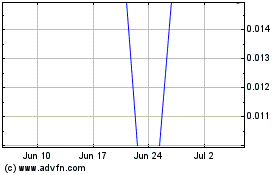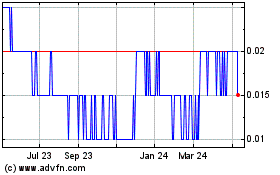Silver Spruce Reports on Independent Assessment of its Big Easy Epithermal Au-Ag Prospect
September 26 2013 - 7:00AM
Marketwired Canada
Silver Spruce Resources Inc. (TSX VENTURE:SSE)(FRANKFURT:S6Q) is pleased to
report the results of an evaluation of the Big Easy low-sulphidation epithermal
gold-silver zone in eastern Newfoundland by international expert Jeffrey
Hedenquist of Ottawa, ON. Dr. Hedenquist has practiced his profession as a
geologist continuously since 1975, working as a researcher for the U.S.
Geological Survey, the New Zealand Department of Scientific and Industrial
Research, and the Geological Survey of Japan until the end of 1998. Since then
he has been an independent consultant completing assignments in over 35
countries world-wide for over 75 clients. He publishes widely in international
refereed journals on subjects related to epithermal and porphyry ore-deposit
formation and active hydrothermal systems.
As required by Dr. Hedenquist in his evaluations, the "Summary" of his report
follows in its entirety:
"The Big Easy prospect shares numerous features typical of sulfide-poor
epithermal vein systems that have experienced little erosion. The northerly
striking structures are hosted by the Rocky Harbour Formation, an arenitic
sedimentary package with horizons containing a volcanic component; there are
also flow-banded rhyolites present. These characteristics are due to its
location in an extensional basin, a few km west of the margin of a
Neoproterozoic volcanic arc.
Evidence for preservation of the paleosurface comes from the presence of finely
laminated silica gels, with deposition in a lacustrine basin. Periods of
syn-hydrothermal clastic input may have been caused by sudden uplift and
erosion, likely due to movement on local faults in this rift setting. The
subsidence was at least 25 m, possibly up to 70 m (or more), which would have
progressively buried veins to a deeper level below the prograding paleosurface.
The structures outcropping at the surface range from mm-wide veinlets to
meter-wide veins, at high angles to sedimentary bedding that has been tilted
post-mineral approx. 30 degrees to the west. Early prospecting, from 1994 to
2009, identified areas with up to approx. 0.4 g/t Au; since 2010 Silver Spruce
has collected samples reporting up to 2 g/t Au and 13 g/t Ag at the surface.
These grades are highly anomalous since the present erosion level is essentially
the paleosurface, where grades in veins are typically low. The initial seven
drill holes in 2011 (1577 m) along more than 900 m of north-south strike extent
(with a drill gap of approx. 500 m) encountered narrow veins. At the southern
and northern limits of drilling, intervals of 1.5 to 1 m contain up to 6.05 g/t
Au and 174 g/t Ag, and 7.65 g/t Au and 10 g/t Ag, respectively. These results
come from 30 to 170 m depth, i.e., near the top of the epithermal environment,
and indicate the potential for grade development at Big Easy. The veins show
evidence for banding, including colloform bands, zones of quartz that have
replaced bladed calcite and quartz-adularia intergrowths (all three consistent
with boiling in fractures), and rare occurrences of bands of acanthite; these
features are typical of low-sulfidation epithermal veins. The second round of
drilling did not penetrate below the initial higher grade zones, which is
necessary to determine the potential for deeper bonanza grades that are the
hallmark of the most notable examples of this deposit style. In addition, the
effects of the now-tilted faults on vein continuity with depth, remains to be
determined.
The large strike extent, 900 m, of significant grades (up to approx. 8 g/t Au
and 170 g/t Ag over approx. 1 m widths at shallow depths, less than 170 m depth
below the paleosurface), indicates a potential that has yet to be adequately
tested. The soil results indicate that the prospect may be open to the north;
the occurrence of the ET zone, approx. 3.5 km south, indicates further potential
to the south. Thus, there is potential to be tested both along strike as well as
at depth, at least to approx. 250 m below the present surface to determine if
there is a sharp top to a possible bonanza-grade shoot."
The evaluation by Dr. Hedenquist has confirmed that the Big Easy zone has many
characteristics of typical low sulphidation, epithermal systems, and although
comparatively old, dated at about 570 Ma, the system is relatively pristine and
undeformed. Textures and veins in outcrop indicate that the present surface is
the paleosurface (i.e., historical surface where hot springs were present) and
that high-grade gold-silver veins, if present, should lie deeper (with tops up
to 250+ m vertical) below the present surface, and that this potential has not
been adequately assessed by the exploration carried out to date.
To view Drill hole BE-11-03-20 m; clastic accumulation during deposition of a
silica gel horizon (from a hot spring) in a shallow lacustrine setting,
indicating that rift extension and down-faulting occurred during hydrothermal
activity and gold deposition (Hedenquist, Sept. 2013), please visit the
following link: http://media3.marketwire.com/docs/900686_image.jpg.
The President and CEO of Silver Spruce, Peter Dimmell, says "Dr. Hedenquist's
evaluation has confirmed that the Big Easy zone has many characteristics typical
of low-sulphidation epithermal systems, with the potential for high-grade gold
and silver veins at depth, and these have yet to be tested. This is an important
road accessible property which carries significant upside potential for our
shareholders. We are working diligently to raise capital for continued
exploration, preferably through a joint venture rather than further dilution of
our stock.".
The Company owns 100% of the Big Easy property, subject to advance royalty
payments of $20,000 per year and a 3% NSR on any production, of which 1.5% can
be bought for $1.5 M. Maps and pictures showing the locations for the above
noted areas and the diamond drilling are on the Silver Spruce website at
www.silverspruceresources.com
This release has been approved by Peter M. Dimmell, P.Geo. President & CEO of
Silver Spruce Resources Inc., who is a Qualified Person (QP) in NL and ON as
defined in National Instrument 43-101.
About Silver Spruce Resources Inc.
Silver Spruce is a diversified junior exploration company with a significant,
road accessible, low sulphidation, epithermal, gold/silver property in eastern
Newfoundland, which has potential for bonanza grades in both gold and silver -
the Big Easy, and for the longer term, a portfolio of uranium (Snegamook, A7
(Fishawk Lake), Double Mer, Mount Benedict, CMBJV) and rare earth (Pope's Hill,
Pope's Hill JV (w/ Great Western Minerals Group), Straits) projects in Labrador.
Information on the company can be found on the Silver Spruce website at
www.silverspruceresources.com.
Neither TSX Venture Exchange nor its Regulation Services Provider (as that term
is defined in the policies of the TSX Venture Exchange) accepts responsibility
for the adequacy or accuracy of this release. The company seeks Safe Harbour.
FOR FURTHER INFORMATION PLEASE CONTACT:
Silver Spruce Resources Inc.
Peter Dimmell
President/CEO and Director
709.739.5608
709.739.0761 (FAX)
pdimmell@silverspruceresources.com
www.silverspruceresources.com
Silver Spruce Resources (TSXV:SSE)
Historical Stock Chart
From Dec 2024 to Jan 2025

Silver Spruce Resources (TSXV:SSE)
Historical Stock Chart
From Jan 2024 to Jan 2025
